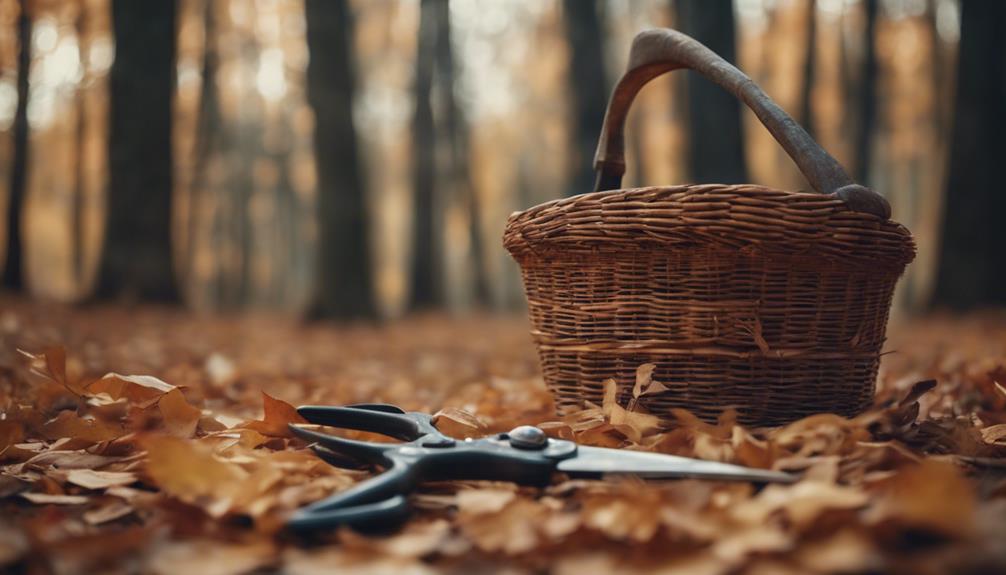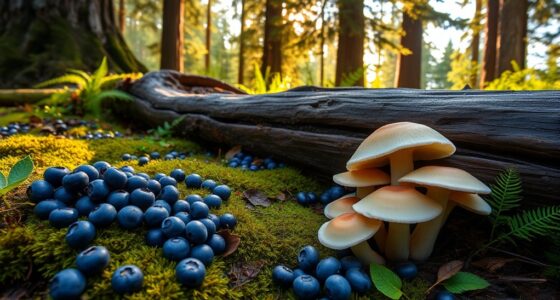You can forage for wood, and with the right knowledge, you can harvest high-quality wood while minimizing your environmental impact. Target hardwood trees like oak, maple, and ash for efficient burning, and avoid softwoods like pine, spruce, and cedar. Look for dead or fallen trees for easier collection and minimal impact. Inspect trees for signs of disease, rot, or insect damage before harvesting. Learn from trusted sources, join foraging communities, and practice ethical foraging to respect wildlife habitats. By following proper techniques, you can collect quality wood while preserving the environment, and discover more about sustainable wood foraging practices ahead.
Key Takeaways
- Identify hardwood trees like oak, maple, and ash for efficient burning, and avoid softwoods that produce more creosote.
- Obtain landowner consent, research local regulations, and harvest responsibly to avoid legal issues and environmental harm.
- Inspect trees for signs of disease, rot, or insect damage before harvesting, and prioritize collecting dead or fallen wood.
- Learn from trusted sources, join foraging communities, and start with easy-to-recognize species to ensure sustainable and ethical wood foraging practices.
- Prioritize the health of the forest by only taking what you need, and adopt sustainable practices like replanting trees and collecting only dead or fallen wood.
Identifying the Right Trees
When foraging for wood, start by targeting hardwood trees like oak, maple, and ash, as they burn more efficiently and produce less smoke than softwoods.
These plants are ideal for firewood because they're denser and have a higher energy content, making them burn longer and hotter.
Avoid softwoods like pine, spruce, and cedar, which may seem like a convenient option, but they burn faster and produce more creosote, making them a less desirable choice.
As you search for the right trees, keep an eye out for dead or fallen trees, which are easier to collect and have less impact on live plants.
Before harvesting, inspect the trees for signs of disease, rot, or insect damage to make sure you're collecting healthy wood.
Safe and Sustainable Foraging

As you venture into safe and sustainable foraging, it's crucial to prioritize responsible harvesting practices, identify the right species, and respect environmental limits. Always ensure that you take only what you need, leaving enough for wildlife and future growth. Equally important is understanding which plants are safe for both humans and animals, as some species can be harmful if misidentified. For example, knowing the daily forage needs for horses is vital when selecting vegetation, as improper grazing could harm their health or damage the landscape. Additionally, educating yourself about the local ecosystem and the specific growth patterns of the plants you’re foraging ensures that you don’t disrupt the balance of the environment. Understanding the *daily forage needs for horses* not only helps maintain their health but also prevents overgrazing, which can lead to soil erosion and reduced biodiversity. By being mindful of these factors, you contribute to a more sustainable relationship with nature.
You'll want to adopt habits that promote healthy forests and minimize your ecological footprint.
Responsible Harvesting Practices
By adopting responsible harvesting practices, you secure that your wood foraging endeavors not only minimize environmental harm but also maximize the benefits of this sustainable resource.
When foraging for wood, timing is essential. Consider the time of year and the condition of the wood. Avoid harvesting during extreme weather conditions, as this can damage the wood and the surrounding environment. Always obtain landowner consent before foraging, and research local regulations to avoid legal issues.
Practice safe and sustainable foraging by avoiding overharvesting and considering the environmental impact of wood collection. Utilize proper tools and techniques for wood harvesting to ensure personal safety and efficiency. Research and follow specific guidelines on which types of wood are suitable for burning to maximize the benefits of foraged wood.
Identify Edible Species
To guarantee a safe and sustainable foraging experience, you'll need to develop the skills to accurately identify edible species, distinguishing them from their toxic lookalikes. This important step ensures you'll enjoy the fruits of your labor without risking your health.
Here are some essential tips to get you started:
- Learn from trusted sources: Consult field guidebooks and reputable online sources to learn about edible species, their habitats, and any lookalikes that might be toxic.
- Join a foraging community: Connect with local foraging groups or workshops to enhance your knowledge and skills in identifying edible plants, fungi, and fruits in the wild.
- Practice ethical foraging: Only harvest what you need, respect wildlife habitats, and obtain necessary permits when foraging on public land.
- Start with easy-to-recognize species: Begin with plants like dandelions, nettles, and ramps before progressing to more advanced foraging options to build confidence and expertise.
Respect Environmental Limits
You'll need to adopt sustainable foraging practices to make certain that your wood foraging activities don't harm the environment, especially since the consequences of overharvesting can be devastating.
Overharvesting can lead to deforestation and habitat destruction, causing long-term damage to the ecosystem. To avoid this, prioritize the health of the forest by only taking what you need and leaving the rest to support biodiversity. Follow local regulations and guidelines on wood collection to make sure you're not harming the environment.
Consider the long-term impact of your wood foraging activities on the environment and future generations. Sustainable foraging practices involve replanting trees and only collecting dead or fallen wood. By doing so, you'll be guaranteeing the forest remains healthy and thriving for years to come.
Wood Types for Different Uses

When it comes to using foraged wood for different projects, you'll want to choose the right type of wood for the job.
You'll find that hardwoods, like oak and maple, are perfect for building furniture that'll last, while softwoods, like pine and spruce, are better suited for framing and construction.
Hardwoods for Furniture
Hardwoods like oak, cherry, maple, walnut, and mahogany are prized for their unique characteristics, making them ideal for crafting high-quality furniture pieces that exude style and sophistication. As you forage for wood, keep an eye out for these hardwoods that will elevate your furniture-making game.
Here are some popular hardwoods for furniture making:
- Oak: Durable and attractive, oak is perfect for creating statement pieces.
- Cherry: Rich in color and smooth in finish, cherry wood is ideal for high-end furniture.
- Maple: Strong and versatile, maple takes on different finishes beautifully.
- Walnut: Luxurious and elegant, walnut is perfect for creating sophisticated furniture pieces.
When foraging for wood, remember that these hardwoods are highly sought after for their unique characteristics. Oak's durability and attractive grain patterns make it a popular choice, while cherry's rich color and smooth finish make it ideal for high-end pieces. By understanding the characteristics of each hardwood, you'll be able to create stunning furniture pieces that showcase your craftsmanship.
Softwoods for Framing
As you shift your focus to framing, consider softwoods like pine, spruce, and cedar, which offer a winning combination of lightweight, easy workability, and cost-effectiveness.
When foraging for wood, you'll find that these softwoods are ideal for framing due to their unique characteristics. Pine, for instance, is a popular choice for construction projects due to its affordability and availability. It's a great option for framing, especially when budget is a concern.
Spruce, on the other hand, is valued for its straight grain and strength, making it perfect for framing where structural integrity is essential.
Cedar, with its natural resistance to decay and insects, is a durable choice for outdoor framing projects. Unlike foraging for wild foods, which requires careful identification, identifying the right softwood for framing is more about understanding their characteristics.
By choosing the right softwood, you'll be able to create a sturdy and cost-effective frame that meets your needs.
Inspecting for Rot and Damage

You'll want to carefully examine each piece of wood for signs of rot or damage, as these can greatly impact its burning quality. Taking the time and effort to inspect each piece will guarantee you're collecting high-quality wood that will burn efficiently.
Here are some key signs to look out for:
- Soft spots or discoloration: Indicates rot, which can affect burning quality.
- Cracks, splits, or insect holes: Damage that can impact the wood's burning performance.
- Waterlogged or excessively damp wood: Will be challenging to ignite and may produce poor burning results.
- Disease or infestation signs on the bark: Can impact the burning process and produce harmful smoke.
Responsible Harvesting Techniques

Now that you've inspected your wood for quality, it's time to think about where you're sourcing it from, and obtaining landowner consent before collecting wood is a necessity to promote responsible harvesting practices. This guarantees you're not trespassing or causing harm to private or protected areas.
Consider exploring local council land, which may even offer tax rebates for your wood collection efforts. You can also inquire at local builders' merchants for broken pallets, a sustainable source of wood.
When out foraging, explore forested areas, especially after windy days, to gather fallen branches. Even dog walks can be a convenient opportunity to collect kindling or logs for burning. Remember, responsible harvesting techniques prioritize the environment and respect for landowners.
While you're out collecting wood, keep an eye out for edible plants, like wild mushrooms or berries, which can be a tasty bonus to your foraging adventure. By following these responsible harvesting techniques, you'll be well on your way to collecting quality wood while preserving the environment.
Preparing Wood for Use

With your responsibly harvested wood in hand, it's essential to prepare it for use to guarantee efficient burning and safety. Just like food foraging, where you make sure your finds are safe to eat, you must prepare your wood to get the best out of it.
Here are some essential steps to follow:
- Season your wood: Let it sit for a year to optimize burning efficiency and reduce smoke emissions.
- Cut it to size: Use a bow saw to cut your wood into manageable sizes for burning.
- Choose the right wood: Seek advice on suitable woods for burning from reliable sources to ensure safety.
- Store it properly: Keep your wood dry and protected from the elements to maintain its quality and prevent decay.
Creative Ways to Repurpose Wood

As you've optimized your wood for burning, consider repurposing some of it to create unique, eco-friendly pieces for your home or outdoor space. You can transform old wooden pallets into stylish shelves, tables, or planters perfect for growing plants. Salvaged wood from demolition sites can be upcycled into DIY projects like picture frames or accent walls, adding a touch of rustic charm to your decor.
Here are some creative ways to repurpose wood:
| Old Wood | New Creation |
|---|---|
| Fallen branches | Outdoor seating or garden borders |
| Wooden pallets | Stylish shelves or planters |
| Salvaged wood | Picture frames or accent walls |
| Logs | Unique art pieces or decorations |
Common Mistakes to Avoid

When foraging for wood, heedlessness can lead to trouble, and it's essential that you're aware of the common pitfalls to avoid. You don't want to end up with a bad batch of wood that's unfit for burning or, worse, get into legal trouble.
Here are some common mistakes to avoid:
- Lack of landowner consent: Always get permission from the landowner before collecting wood to avoid legal issues.
- Insufficient seasoning: Don't forget to allow your wood to season properly for efficient burning.
- Overexertion: Be mindful of your physical limits and avoid carrying heavy loads of wood to prevent strain or injury.
- Environmental neglect: Be mindful of the environmental impact when foraging for wood to maintain ecosystem balance, ensuring that your actions don't harm the environment or disrupt the natural food source.
Frequently Asked Questions
When to Forage for Spruce Tips?
You're wondering when to forage for spruce tips? Typically, it's late spring to early summer, around May to June, when the new growth appears as bright green, tender shoots, perfect for harvesting!
What Is the Rule of Thumb for Foraging?
You follow a simple rule of thumb when foraging for wood: only take what's already on the ground or what you can safely harvest without damaging the tree or ecosystem, ensuring sustainability.
Can You Eat Fir Tips?
You might worry that fir tips are bitter or inedible, but surprisingly, they're not only safe to eat, but also packed with Vitamin C and a citrusy flavor, making them a tasty addition to teas, salads, and more.
Can You Eat Spruce Tips Raw?
You can eat spruce tips raw, but in moderation, as large quantities may cause stomach discomfort. Research proper identification and preparation methods to enjoy them safely, and consider incorporating them into recipes for a unique flavor.
Conclusion
As you venture out to forage for wood, coincidence has it that you've stumbled upon the perfect guide. By now, you've learned the ins and outs of identifying the right trees, ensuring safe and sustainable practices, and preparing wood for use.
Remember, responsible harvesting techniques and inspecting for rot and damage are key. With your newfound knowledge, go forth and forage like a pro, and who knows, you might just stumble upon a hidden gem in the woods!










